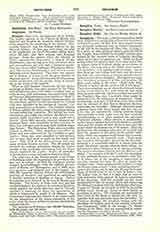

Seraphim .— The name, a Hebrew masculine plural form, designates a special class of heavenly attendants of Yahweh’s court. In Holy Writ these angelic beings are distinctly mentioned only in Isaias‘s description of his call to the prophetical office (Isa., vi, 2 sqq.). In a vision of deep spiritual import, granted him in the Temple, Isaias beheld the invisible realities symbolized by the outward forms of Yahweh’s dwelling place, of its altar, its ministers, etc. While he stood gazing before the priest’s court, there arose before him an august vision of Yahweh sitting on the throne of His glory. On each side of the throne stood mysterious guardians, each supplied with six wings: two to bear them up, two veiling their faces, and two covering their feet, now naked, as became priestly service in the presence of the Almighty. His highest servants, they were there to minister to Him and proclaim His glory, each calling to the other: “Holy, holy, holy; Yahweh of hosts; all the earth is full of His glory.’ These were seraphim, one of whom flew towards Isaias having in his hand a live coal which he had taken from the altar, and with which he touched and purified the Prophet’s lips, that henceforth these might be consecrated to the utterances of inspiration. Such, in substance, is Isaias‘s symbolical vision from which may be inferred all that Sacred Scripture discloses concerning the seraphim. Although described under a human form, with faces, hands, and feet (Is., vi, 2, 6), they are undoubtedly existing spiritual beings corresponding to their name, and not mere symbolic representations as is often asserted by advanced Protestant scholars. Their number is considerable, as they appear around the heavenly throne in a double choir and the volume of their chorus is such that the sound shakes the foundations of the palace. They are distinct from the cherubim who carry or veil God, and show the presence of His glory in the earthly sanctuary, whilst the seraphim stand before God as ministering servants in the heavenly court. Their name too, seraphim, distinguishes them from the cherubim, although it is confessedly difficult to obtain from the single Scriptural passage wherein these beings are mentioned a clear conception of its precise meaning. The name is oftentimes derived from the Hebrew verb saraph (“to consume with fire”), and this etymology is very probable because of its accordance with Isa., vi, 6, where one of the seraphim is represented as carrying celestial fire from the altar to purify the Prophet’s lips. Many scholars prefer to derive it from the Hebrew noun saraph, “a fiery and flying serpent”, spoken of in Num., xxi, 6; Isa., xiv, 29, and the brazen image of which stood in the Temple in Isaias‘s time (IV Kings, xviii, 4); but it is plain that no trace of such serpentine form appears in Isaias‘s description of the seraphim. Still less probable are the views propounded of late by certain critics and connecting the Biblical seraphim with the Babylonian Sharrapu, a name for Nergal, the fire god, or with the Egyptian griffins (serif) which are placed at Beni-Hassan as guardians of graves. The seraphim are mentioned at least twice in the Book of Enoch (lxi, 10; lxxi, 7), together with and distinctly from the cherubim. In Christian theology, the seraphim occupy with the cherubim the highest rank in the celestial hierarchy (see Cherubim), while in the liturgy (Te Deum; Preface of the Mass) they are represented as repeating the Trisagion exactly as in Isa., vi.
FRANCIS E. GIGOT

